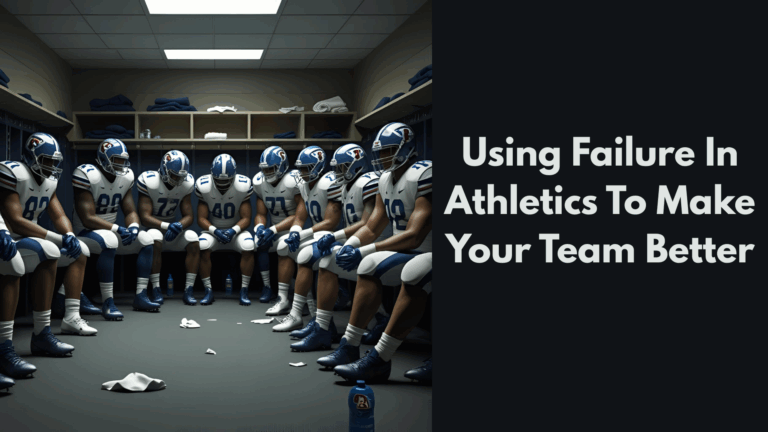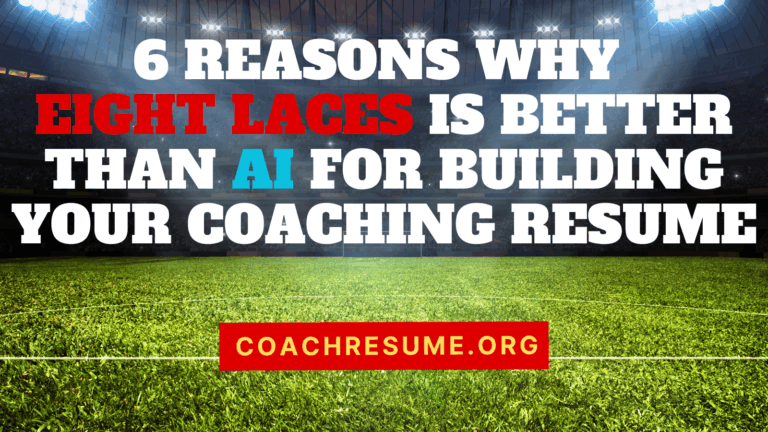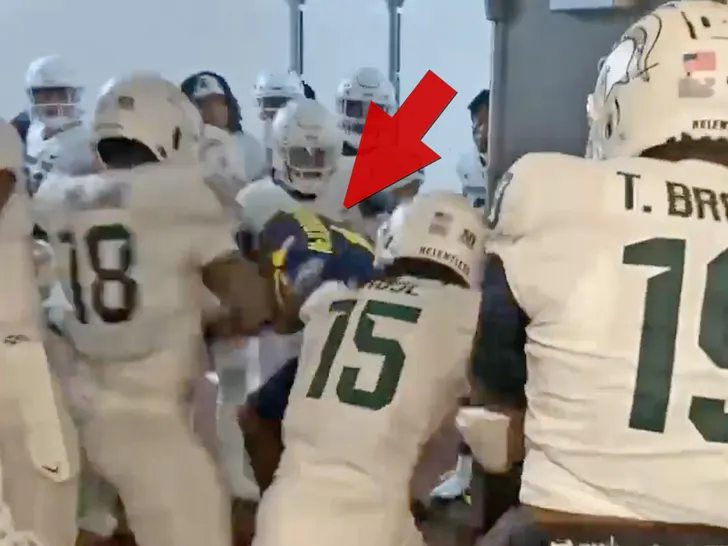
The “Backward Brawl” took on a whole new meaning recently. The annual football game between Michigan and Michigan State took a turn for the worse. But it wasn’t DURING the game, it was afterwards.
The footage took to social media immediately, as always is the case now, and what was burned into everyone’s minds from that game was not the great on field play of the victors but the tunnel chaos that followed.

And wouldn’t you know that this game and tunnel brawl came just DAYS after I was talking with my good friend and longtime football coach and athletic director Kevin Swift about post game fights. I had seen a pretty ugly situation the Friday before this Michigan/Michigan State game, and reached out to some coaches I admire. “Coach, do you have any written protocol to help coaches avoid situations like this?” Then I explained what I saw. Nobody I reached out to had anything written down.
So, Coach Swift and I thought it would be a great idea to put together some guidelines for coaches to read, and perhaps develop their own policy from. I had written about How To Handle A Bench Clearing Brawl before, but nothing AFTER a game. So, here we go!
Thoughts from Kevin Swift
Chris Fore does a superb job talking about how to handle a bench clearing brawl in the middle of the game, and setting up some expectations for everyone, and we adhere to these same ideas. Never, and we mean never put your hands on an opponent, opposing coach, opposing fan, or official. Never get into a verbal argument with an opponent, opposing coach, opposing fan, or official. His teachings and ideas here are golden! I would like to expand on these ideas into after-the-game situations and conflicts that arise in today’s games far too often.
Most coaches in high school attempt to prepare for every situation that can come up in a game, but how many prepare for all hell breaking loose after the game? Yet every year we see video of craziness occurring after the games. Most recently the conduct of Michigan State players harming a Michigan player after the game.
The first ugly event I recall was watching my younger brother’s Servite team get into a fistfight with a Morningside team after a hard fought 7 on 7 contest during the summer. It was ugly and harmed the reputation of both schools, as it should have. As Coaches we are responsible for our student-athletes until they are given to their parents, that is the law in most states. So, what teachings and measures can be done to reduce after game conflicts or brawls?
Teach, Teach Again & Re-enforce
So many of us talk about Culture, and yet do not understand that Culture is how and what we do all day long not just during the 48 minutes of a football game or at the 2-hour practice, or hour of weightlifting in the off season.
We at Gold Beach have always emphasized the point that during times of crisis we all sink to the level of our training, so how are we training our student-athletes to act daily and in times of crisis? My players can tell you that Coach Swift has always told them that wins and losses should never ever define who they are as a person, but it is how we respond or deal with this success and failure that will define us as a person or student-athlete.
At the end of the day or in this case the game, it is how we conduct ourselves and respond to the outcome that will define us. So as a staff we are constantly teaching not only how to perform or execute systems or schemes but also how to conduct ourselves when we are successful and more importantly when we fail. We tell our kids that the casual observer of our contest should not be able to tell if we are losing or winning but just see the energy we are putting forth.
Some examples of our teachings: if you score, just hand the ball off to an official and act like you have done it 100 times, or if you get beat for a touchdown or lose a fumble keep your head up, let it go, refocus, and get better. As coaches we need to model this behavior as well! Slamming down a clipboard in frustration is bad modeling, not that we do not get the frustration we all feel at times, but we must also teach by example not just words. This is especially true after a hard fought contest where we come up short of our goal to win. We talk and teach to keep our heads high, and mouths shut and that we can talk about it in the privacy of our own locker room, but while we are on the field we must act with class and dignity. We talk about this every day at practice and after practice. We also do several things to help our kids out of awkward situations that can lead to conflict.
Shaking Hands after the Contest
Shaking opponents’ hands after the game is one of the areas where a conflict can arise because everyone’s emotions are still high and right on the surface. We gather first, your opponent will wait, trust me, and remind our kids of our expectations, win or lose. As the kids line up to move across the field to shake hands, our coaches will spread out on the left side of the team rather than the customary end of the line. We do this so we can keep a close eye on our kids and if something goes awry, we are in great proximity to stop it immediately. Being at the end of the line does not allow you to see what is going on in front of you and we must know what is going on in that line.
Leaving a Field or Stadium with Only One Exit
Michigan is not the only football venue with only one exit or tunnel, most high schools have one gate onto the field. Conflict in this situation is often unavoidable, after a hard-fought contest or a lopsided contest. We adhere to this practice to help avoid these situations. The visiting team should be allowed to leave first; as the home team we will kill the time by cleaning up our bench area or undressing the field. If we are the visiting team and the home team does not adhere to the same practice we do, we will wait and clean up our bench area before heading to the locker room. Under no circumstances will we be at the exit with the team we just played.
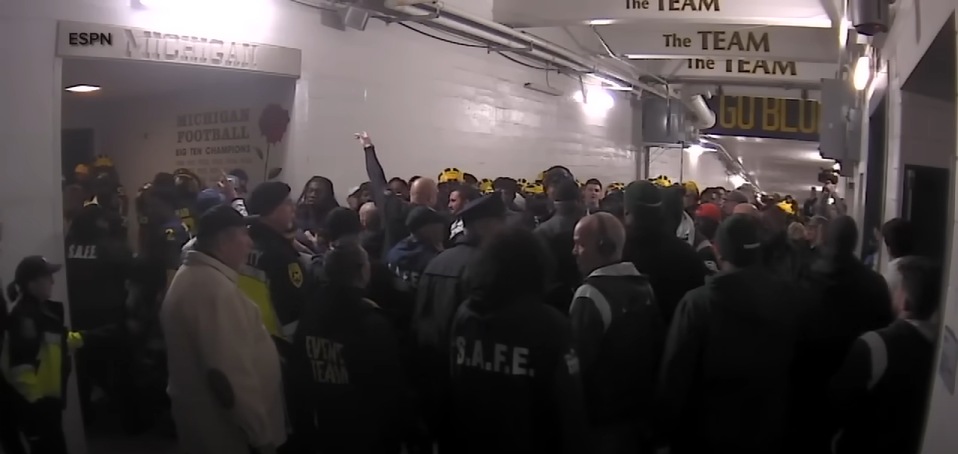
Thoughts from Chris Fore
You have to plan, and you have to practice the plan
This is the very first step, you have to have a plan. Without a plan, you don’t have a way to prevent something negative from happening. Coach Swift presents some great ideas above in terms of one entrance and the handshake line. Practice the handshake line before your first game. Seriously, line everyone up and do it. Without setting firm expectations, and practicing even the most rudimentary things like how to line up to shake hands will not help you at the end of the day if there is an issue. Be prepared!
A plan is great, but without practicing the plan with your team, it can be useless to have. Do not just allow the plan to sit on the shelf of an administrator, athletic director or coach. Make the plan come to life. Practice it, teach it.
Helmets On
Remind students to keep their helmets on until they get back to the team huddle. Sometimes teams will meet back on their sidelines after the handshake, sometimes they’ll go down to an endzone. Remind players that from when that clock hits :00 until they get back to their own team’s area, they must keep their helmets on and strapped the entire time.
If A Fight Breaks Out, Go To Our Rallying Point
If a fight starts while you are going through the handshake line, the best way to get that thing to stop, and prevent your players from taking part is using “group think.” This means getting your group to all think the same. And in this case, it needs to be “Clear the field.” Get to a rallying point. Train them what that means.
Use the same vocabulary with your team, all coaches need to teach and use the phrase “Clear the field now.” This means, CLEAR THE FIELD NOW! Teach your team where to go, the rallying point, when you are at home if a fight breaks out. Teach your team where to go when you are on the road if a fight breaks out. “If we start clearing the field (at home) you are to go straight to the locker/team room,” or “If we have to clear the field we will all meet right next to our home stands on the track.”
This might be the best plan if your locker room is a little distance from the stadium like mine was when I played; we had to walk about 400 yards to our locker room from the field. That is NOT a good place to meet if a fight breaks out after the game because there is just too much space between those two points.
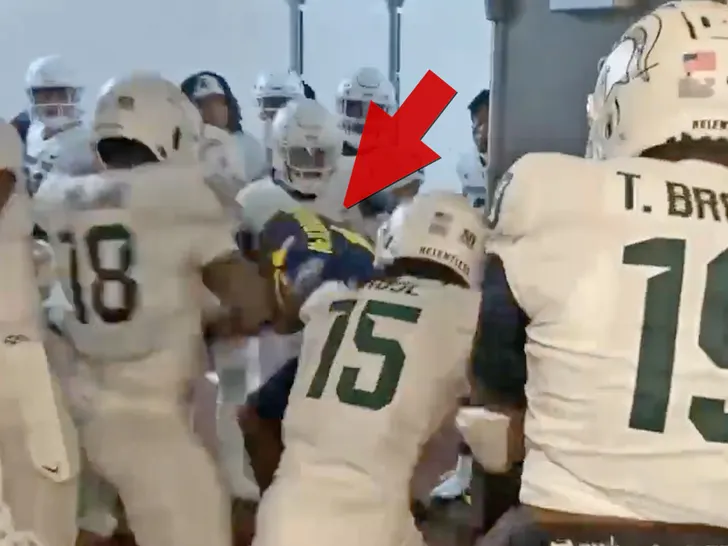
Grab Each Other
Teach your team how to grab each other to get to the rallying point. “When you here our coaches telling you go CLEAR THE FIELD NOW, start grabbing your teammates to clear the field. Take care of each other, leave no man behind. Grab everyone you can with our jersey, and get to the rally point. Don’t leave any jersey of our by themselves. An important piece on this coaching point is also “Do not touch the other team.” Grab your own guys, don’t touch them.
Know the pulse of the game
You have to anticipate the after game responses. What is the tenor of the last quarter? Is it a blowout with a lot of contention or a blowout where everyone is cool with each other? A local rivalry game for 75 years that usually ends with a bunch of hugs and kisses? Or a local rivalry game for 75 years that usually ends with fisticuffs?
The last quarter of that game for football, basketball, the last 2 innings for baseball and softball, the last 3 minutes for basketball, etc., administration needs to be in tune with what is happening. It’s important to not only be in tune with what is happening on the field, but what is happening in the stands too. Are the fans getting “chippy” with game management? Or are they chill?
If you’re an Athletic Administrator or Principal who can’t really “understand” the tenor of the game, and what I’m talking about here, then talk with your Head Coach about this aspect of this article. He or she will explain it.
Clear The Sidelines If . . . .
A lot of high schools will allow a lot of different folks on the sidelines. Alumni, donors, parents, an assortment of bodies might be on the sidelines. Mix in stat crews, athletic training girls, media, school media, ASB, equipment people, etc. etc.
If the game is getting chippy as you are feeling the pulse of the game for the last few minutes, start to clear the sidelines at about 4:00 minutes on the clock. The more bodies that you can get off the field and “behind the gates” the better if anything on the field does “pop off” after the game. The last thing you want are some alumni out there fighting current students of the opposing team.
Use The PA and Lights
If you do anticipate some problems after the game, start to make public address announcements to warn people about trespassing (this could be in your local civil law ordinance), school rules, etc. Use positive language to thank them for supporting these student-athletes, and for supporting the school, and now for kindly going to your cars and driving home safe. Start to dim the lights faster than you usually do to “send a message” that it’s time to head home. The PA and the lights are some of the most underutilized “people movers” at high school stadiums.
A Plan For the Officials
When I was an Athletic Director and Head Football Coach at the same time, I always assigned my Assistant Athletic Director (who was also our Head Basketball Coach) to the officials on game night. That was his main duty outside of overseeing the gate operations. He would escort them to their locker room pregame, halftime and postgame. This is KEY. Do not let your officials just find the locker room on their own. You must have a school administrator with the crew to help keep them safe and secure. I suggest a security guard as well. If you don’t, and something happens, good luck getting decent officials for YEARS! Seriously, this will have a ripple effect on who chooses your games.
The escort should talk about an exit strategy before the game. “How do you want me to help you off the field?” Sometimes guys like to go straight to their cars, sometimes they want to go to the locker room. Communicate this clearly before the game, then execute it.
Get the locker rooms open
I was at a game this year where there was almost a very ugly scene on the field after the game. It was very close to becoming an all out, every man for himself, type of fight as adults almost came to blows. I’m very glad that didn’t happen. It took about 6-7 minutes to sort everything out. The home team got into their locker room very quickly. The visiting team was at their locker room, but the door wasn’t open.
In the hubbub that followed the game, nobody thought to open the visiting team locker room. So, they all gathered outside of their locker room, and it almost looked like an intentional act that they were locked out. I know that it wasn’t. The security guy assigned to unlock the door was out trying to calm down the crowd. It should have been made VERY clear to him to get that locker room door open. Because as that team was standing around, more agitation started, and it almost flared up again. This was very unavoidable. Get the stinking locker room unlocked.
Film the Handshake Line
Last thing here – keep that camera rolling! We had a nasty scene after a game once when I was an Assistant Principal. It was at rival school. We poured over the video for hours, frame by frame, second by second, minute by minute to see who was guilty of throwing punches, of spitting, and who was helping to break everything up. That video told a story of every individual on that basketball court. We were able to really grasp how and why that fight happened. Law enforcement was involved. Without the video, we would have had a lot of accusations and untruths of exactly who was guilty of what.
So, train your video guy to keep that film rolling until both sides are separated after the handshake line. Better to be safe than sorry. Let it run for an extra 5 minutes, not zoomed in, just running. Shoot, have your sideline and your endzone cams going. That film might not only save a student-athlete playing time, but it might even save YOUR career!
It is Chris and my hope that this article can provide a framework for Coaches to follow to help avoid these ugly events from happening after their respective contests.
Chris Fore has his Masters in Athletic Administration, is a Certified Athletic Administrator and serves as the President of the California Coaches Association. He is the Principal of a STEM charter school with 1,750 students in Southern California. He coached high school football for 16 years (8 as a Head Coach) and JUCO football in his last year (2017), before becoming an Administrator. Fore served as an Adjunct Professor in the Masters of Physical Education program at Azusa Pacific University for three years. He is a court-certified Expert Witness in athletically-based court cases, and is the CEO of Eight Laces Consulting. Eight Laces specializes in helping coaches nationwide in their job search process, and consults schools to fill their vacant positions. Fore has been named to the Hudl Top 100 Coaches, and the Top 5 Best High School Football Coaches to follow by MaxPreps. Follow him!
